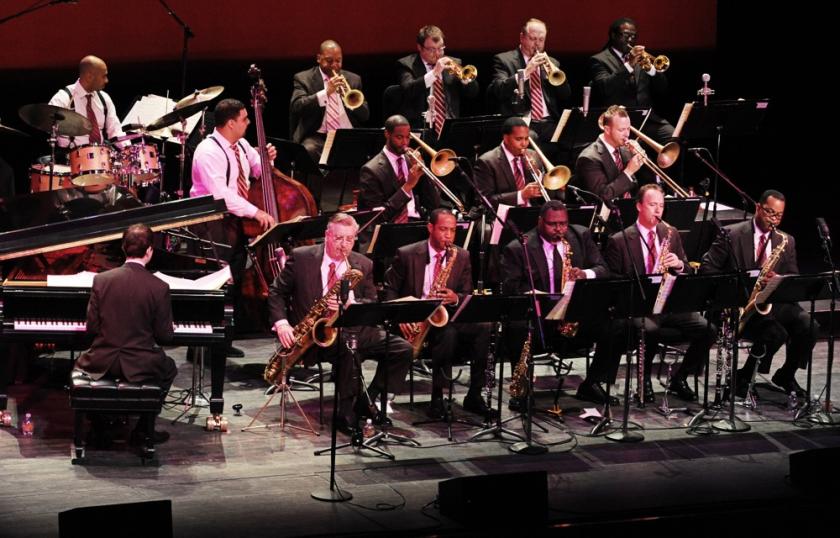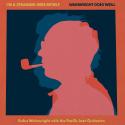If, like Wynton Marsalis, you’re a gatekeeper of the jazz tradition, there’s little you’ll defend more staunchly than the Blue Note back catalogue. With the Jazz at Lincoln Center Orchestra, in London on a short tour, he presented a glossy and intriguing selection of Blue Note repertoire before an ecstatic audience in last night’s Barbican concert. Technically, this was a tour de force. Where the components of some big bands lose definition and melt into a raucous fudge, JALC boasted talon-sharp brass bite, regal articulation, and a deeply golden lustre.
Marsalis’ traditionalism is well known, and his choice of repertoire was intriguing. Blue Note was at the forefront of jazz style from its foundation in 1939, recording Sidney Bechet and Earl Hines in the 1940s, before pioneering bop with Thelonious Monk; none of these made the cut. Donald Byrd’s jazz-rock-soul album Black Byrd became the company’s best-selling LP in 1973. That, perhaps less surprisingly (any instrument with a power cord would have to be introduced to the orchestra over Marsalis’ dead body), was also not the meaning of “best” Marsalis had in mind.
Instead, the selection came almost entirely from the 1960s, when Blue Note was pioneering soul jazz and hard bop. There were three pieces by the great and recently deceased Horace Silver, and two Wayne Shorters, alongside some imaginatively offbeat selections, especially Woody Shaw’s “The Moontrane” (which appeared on Larry Young’s ground-breaking organ album Unity) and Jackie McLean’s muscular “Appointment in Ghana”. The orchestra, much larger, of course, than the ensembles for which most of these were originally composed, was a better match for the tough attack of the Shaw and Shorter than for Silver’s soul- and folk-infused lyricism, though even saxophonist Victor Goines’ intelligent adaptation couldn’t quite find an equivalent orchestral texture to Larry Young’s seedy-sweet organ.
For a British audience, perhaps the evening’s most notable event was the introduction of two youngish British soloists, saxophonist Nathaniel Facey and vibes player Lewis Wright. Facey featured on Silver’s “Peace”, Wright on the same composer’s "Señor Blues", and both on Joe Henderson’s “Inner Urge”. Facey’s slick, athletic phrasing and Wright’s extraordinary virtuosity, playing with several sticks in each hand, both dazzled even in the company of JALC.
The implication that the 1970s were a betrayal was hanging rather heavily in the air
Eventually, though, the arrangements began to sound a bit too similar, the brassiness too glossy, the arrangements needing more rhythmic flex. Even in the 1960s, composers like Shorter and Hancock, who went on to use electronic effects, were stretching the seams of their music, aiming for more than the precise counterpoint of swing. It was almost as if a later painter were to adapt Picasso’s “Weeping Woman” by putting her face together nicely.
One would think that a some of Bechet’s 1940’s Blue Note recordings (he remained with Blue Note even after the label’s centre of gravity was bopping) would make an easier match for the JALC’s precision swing. It was almost as if Marsalis wanted to assert his forward thinking by playing lots of Wayne Shorter, just not the pieces with electronics, like Weather Report, for which Shorter’s now best known. When Marsalis made a little speech about “pure jazz with no commercial concession”, and another about integrity, the implication that the 1970s were a betrayal was hanging rather heavily in the air.
There are trumpeters (Chris Batchelor and Christian Scott spring to mind), who can swing, squeal and scald as hot as Marsalis. They know the traditional repertoire, but they bring the insights of new styles to that repertoire. By the end of the concert, Marsalis’ artistic stance seemed increasingly precarious. The lustre and virtuosity still impress, but the contortion involved in playing new, improvised music from a historical island in the 1960s is looking less and less comfortable.














Add comment